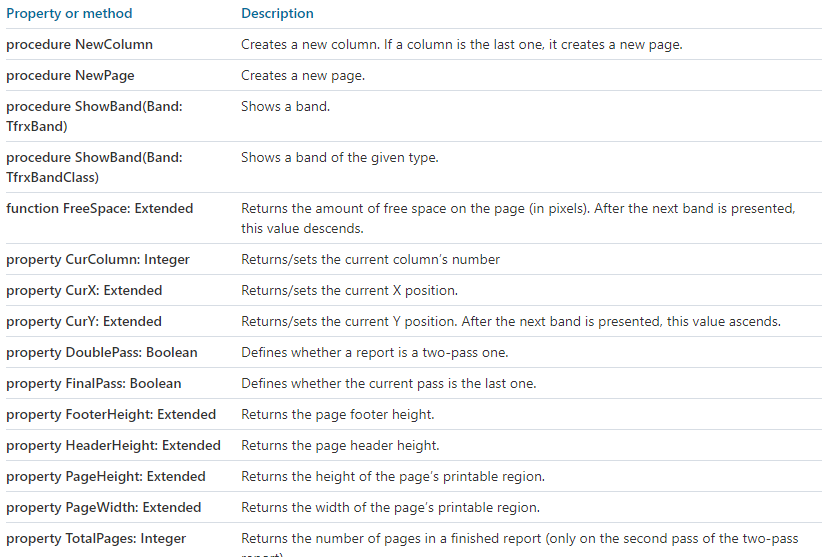FastReport VCL程序员手册:如何借助代码构建报告
修改报告页面的属性
FastReport VCL是用于Delphi,C ++ Builder,RAD Studio和Lazarus的报告和文档创建VCL库。它提供了可视化模板设计器,可以访问为30多种格式,并可以部署到云,网站,电子邮件和打印中。
近日,FastReport VCL更新至v6.9,在新版本中,在PDF更新中增加了对以下对象的并行表单支持:文本,替换和图片。能够通过InteractiveForms字体子集属性将所需的字形仅包含在相互之间形式中。同时修复了多个Bug问题。欢迎下载体验。(旁边向下按钮下载)
FastReport VCL试用版免费下载【慧都网】
有时有必要从代码中修改报告页面设置(例如,修改纸张对齐方式或尺寸)。本TfrxReportPage类包含以下属性,定义页面的大小:
property Orientation: TPrinterOrientation default poPortrait;
property PaperWidth: Extended;
property PaperHeight: Extended;
property PaperSize: Integer;
该PaperSize属性设置纸张格式。这是Windows.pas中定义的标准值之一(例如DMPAPER_A4)。如果为此属性分配了一个值,则FastReport会自动填充PaperWidth和PaperHeight属性(纸张尺寸以毫米为单位)。将DMPAPER_USER(或256)值设置为格式,将意味着已设置自定义纸张尺寸。在这种情况下,PaperWidth和PaperHeight属性应手动填写。
以下示例显示了如何修改第一页的参数(假设我们已经有一个报告):
Pascal:
var
Page: TfrxReportPage;
{ the first report’s page has [1] index. [0] is the Data page. }
Page := TfrxReportPage(frxReport1.Pages[1]);
{ modify the size }
Page.PaperSize := DMPAPER_A2;
{ modify the paper orientation }
Page.Orientation := poLandscape;
C ++:
TfrxReportPage * Page; // the first report’s page has [1] index. [0] is the Data page. Page = (TfrxReportPage *)frxReport1.Pages[1]; // modify the size Page->PaperSize = DMPAPER_A2; // modify the paper orientation Page->Orientation = poLandscape;
借助代码构建报告
FastReport引擎通常负责报表的构建。它以特定顺序显示报告的频段,次数与报告所连接的数据源所需的次数相同,因此形成了完整的报告。有时有必要创建非标准格式的报告,而FastReport引擎无法生成该报告。在这种情况下,可以借助TfrxReport.OnManualBuild事件来手动构建报告的功能。如果要定义此事件的处理程序,则FastReport引擎将管理发送给该事件。同时,以以下方式更改了形成报告的职责分配:
FastReport引擎:
- 报告的准备(脚本,数据源初始化,乐队的树形结构)
- 所有计算(聚合函数,事件处理程序)
- 新页面/列的形成(自动显示页面/列的页眉/页脚,报告标题/摘要)
- 其他日常工作
处理程序:
- bands的演出按一定顺序
OnManualBuild处理程序的本质是发出有关将某些频段呈现给FastReport引擎的命令。引擎本身将完成剩下的工作:只要当前页面中没有位置,就会创建一个新页面。脚本将被执行。
引擎由TfrxCustomEngine类表示。此类的实例的链接位于该TfrxReport.Engine属性中。

让我们举一个简单的处理程序的例子。报告中有两个“主数据”带,它们未连接到数据。处理程序以隔行顺序呈现这些频段,每个频段六次。在六个频段之后,会出现一个很小的间隙。
Pascal:
var
i: Integer;
Band1, Band2: TfrxMasterData;
{ find required bands }
Band1 := frxReport1.FindObject('MasterData1') as TfrxMasterData;
Band2 := frxReport1.FindObject('MasterData2') as TfrxMasterData;
for i := 1 to 6 do
begin
{ lead/deduce bands one after another }
frxReport1.Engine.ShowBand(Band1);
frxReport1.Engine.ShowBand(Band2);
{ make a small gap }
if i = 3 then
frxReport1.Engine.CurY := frxReport1.Engine.CurY + 10;
end;
C ++:
int i;
TfrxMasterData * Band1;
TfrxMasterData * Band2;
// find required bands
Band1 := dynamic_cast <TfrxMasterData *> (frxReport1->FindObject("MasterData1"));
Band2 := dynamic_cast <TfrxMasterData *> (frxReport1->FindObject("MasterData2"));
for(i = 1; i <= 6; i++)
{
// lead/deduce bands one after another
frxReport1->Engine->ShowBand(Band1);
frxReport1->Engine->ShowBand(Band2);
// make a small gap
if(i == 3)
frxReport1->Engine->CurY += 10;
}
下一个示例显示两组bands并排放置。
Pascal:
var
i, j: Integer;
Band1, Band2: TfrxMasterData;
SaveY: Extended;
Band1 := frxReport1.FindObject('MasterData1') as TfrxMasterData;
Band2 := frxReport1.FindObject('MasterData2') as TfrxMasterData;
SaveY := frxReport1.Engine.CurY;
for j := 1 to 2 do
begin
for i := 1 to 6 do
begin
frxReport1.Engine.ShowBand(Band1);
frxReport1.Engine.ShowBand(Band2);
if i = 3 then
frxReport1.Engine.CurY := frxReport1.Engine.CurY + 10;
end;
frxReport1.Engine.CurY := SaveY;
frxReport1.Engine.CurX := frxReport1.Engine.CurX + 200;
end;
C ++:
int i, j;
TfrxMasterData * Band1;
TfrxMasterData * Band2;
Extended SaveY;
Band1 = dynamic_cast <TfrxMasterData *> (frxReport1->FindObject("MasterData1"));
Band2 = dynamic_cast <TfrxMasterData *> (frxReport1->FindObject("MasterData2"));
SaveY = frxReport1->Engine->CurY;
for(j = 1; j <= 2; j++)
{
for(i = 1; i <= 6; i++)
{
frxReport1->Engine->ShowBand(Band1);
frxReport1->Engine->ShowBand(Band2);
if(i == 3)
frxReport1->Engine->CurY += 10;
}
frxReport1->Engine->CurY = SaveY;
frxReport1->Engine->CurX += 200;
}

